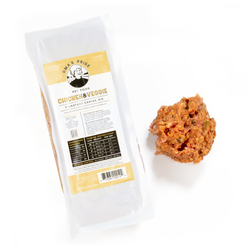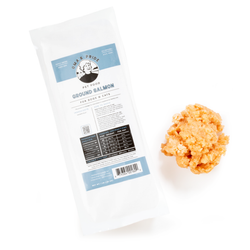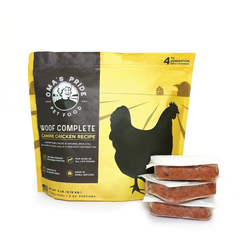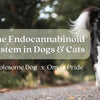The Truth About Raw Food Vs Kibble For Dogs
Did you know that dogs were domesticated around 20,000-50,000 years ago, but that the first commercial dog food didn’t appear until the 1920s?
While this may shock some, our modern conception of dog food hasn’t existed for very long! Before the 1800s, most working or domesticated dogs were fed table scraps, meat, bones, or other animal parts that humans didn’t want.
Today, we’re going to explore the differences between raw food vs kibble, dive into the history of kibble, and explain the pros and cons of both feeding styles.
Table of contents
- The history of dog food and kibble
- What is kibble?
- What is raw dog food?
- 5 key differences: raw food vs kibble
- Conclusion: feeding as many fresh foods as possible
- Frequently asked questions
The history of dog food and kibble

Have you ever wondered when kibble or dog food was invented? To answer these questions, we must dive into the history of dog food.
- Late 1800s: The first dog biscuit was made by an American electrician named James Spratt, who was looking for a convenient way to feed stray dogs. The biscuit ingredients included vegetables, wheat, and blood. Milk-Bone was also invented at this time and gained popularity.
- The 1920s and 1930s: The F.H. Bennett Biscuit Company, the inventors of Milk-Bone, introduced the first dry dog food. Other brands of dry food also became commercially available. Additionally, the first canned wet food was invented by the Chappel Brothers, called “Ken-L-Ration.”
- The 1940s: Although canned wet food became very popular, World War II caused a metal shortage due to its allocation to war materials. This caused a shift from canned wet food to bagged dry food.
- The 1950s: Purina Dog Chow introduced the first true “dog kibble” to the market, which sparked a significant advancement in dry dog food commercialization.
- The 1960s: At this time, extrusion technology was introduced, which standardized the shape and color of food. It also allowed for the mass production of a shelf-stable product. Extrusion is the process of boiling scraps, fat, and meat together and later adding starch and vitamins.
- The 1990s: Oma’s Pride began crafting and distributing raw pet food after a family dog became sick eating dry food. The Signature Mix (made from meat, bones, organs, and vegetables) was born after studying how wolves in the wild ate. After 30 days of the new raw diet, the family dog was fully recovered and healthy!
- Modern day: The pet food industry is huge, as many pet owners purchase their pet's food from a local pet store or online (ref. 1). Pet parents have many brands to choose from, including raw, dry, wet, lightly cooked, freeze-dried, and more.
What is kibble?
Kibble is a dry, commercially available pet food typically made using extrusion.
What is kibble, and how is kibble made? First, ingredients like meat, vegetables, grains, and legumes are boiled together (or steamed) and shaped into standard balls with a brown color spray. Next, vitamins, minerals, and fats are sprayed onto the kibble balls. Finally, the extruded kibble is packaged, sealed, and shipped to pet parents.
Almost all kibbles are highly processed and cooked at high temperatures to preserve shelf life. Kibble also typically contains a high carbohydrate content.
Not all kibbles are made equal
Now, you may be wondering, is kibble bad for dogs?
The quality of store-bought kibble can drastically differ from brand to brand depending on processing, ingredients used, and more. Unfortunately, low-quality kibbles can contain byproducts and raw materials considered “suitable” for dog consumption.
Sadly, ingredients like road kill, dying animals, spoiled human foods, waste, byproducts, and other materials have been known to make it into mass-produced kibbles.
For example, if a kibble bag lists a generic ingredient like “meat meal,” this can legally be sourced from almost any mammal, including road kill or dying animals (ref. 2).
Higher-quality kibbles will include real meat listed toward the beginning of the ingredient list, sourced domestically or from known origins, and contain easy-to-identify ingredient names on the label.
What is raw dog food?
Raw dog food is an uncooked diet for dogs consisting of meat, bones, and organs. A raw diet can also include other nutritional ingredients like dog-safe fruit, vegetables, oils, eggs, seeds, tripe, and dairy products.
Raw diets can be made at home or purchased frozen, dehydrated, or freeze-dried.
A raw diet is good for dogs because it is the most ideal, biologically appropriate option for carnivorous dogs and cats (taxonomically, Carnivora). Dogs' carnivorous characteristics include a short GI tract, elongated sharp teeth, wide jaws, tight molar digitation, no nutritional requirement for carbohydrates, and highly acidic stomachs.
Nervous about feeding raw? Check out common misconceptions about raw food here: Raw Feeding Myths Versus Facts.
Raw feeding models
People typically follow a raw feeding model to achieve a balanced diet.
One of the most popular is the BARF (Biologically Appropriate Raw Food) diet, where it’s recommended that dogs eat “70% muscle meat, 10% raw edible bone, 7% vegetables, 5% liver, 5% other secreting organ, 2% seeds or nuts, and 1% fruit" (ref. 3).
Another popular model is the PMR (Prey Model Raw), which includes 80% muscle meat, 10% raw edible bone, 5% liver, and 5% other secreting organs.
Benefits of raw food for dogs
A dog’s overall health improves when they eat more biologically appropriate whole foods instead of processed or synthetic foods. Specific benefits of a raw diet include:
- Natural allergy relief
- Softer, shinier skin and coats
- Strong, clean teeth and gums
- Improved alertness and cognition
- Better weight control
- Reduced inflammation
- Smaller, less stinky poops
- Boosted hydration
- Improved gut functioning
5 key differences: raw food vs kibble
Now that you understand what raw food and kibble are, let’s dive into some specific differences between the two.

1. Moisture content
One fundamental rule for functioning life is water. We can go weeks without eating, but we can only live 1-3 days without water. Water is vital because it is at the root of every bodily function: hair and skin health, properly working joints, digestion, toxin elimination, and so much more.
Moisture content in kibble
When discussing hydration in raw food vs kibble, the difference is vast. During kibble processing, the moisture is removed to make it more shelf-stable and cost-effective.
Tip! Curious about the moisture percentage in your dog’s food? You can always check it on the back of your bag in the “Guaranteed Analysis” section.
On average, dry dog food contains about 5-10% moisture, which is very low. Sadly, if a dog eats exclusively kibble or dry food without any additional ingredients, it can lead to dehydration in two ways.
First, dogs must choose to go to the water bowl instead of getting water in their meals (and some dogs just aren’t good at that). Second, the body expends its stored moisture to process the food, leaving insufficient water for other bodily functions. If dehydration persists, there's an added risk of inadequate food digestion.
Dehydration concerns can be exacerbated by the high carbohydrate content in the dry food, which is already challenging to digest, especially without sufficient water.
Although it won’t make up for all of the lost moisture content, pet parents can add water, bone broth, or even raw milk to kibble to reduce the chances of dehydration.
Moisture content in raw diets
On average, gently cooked diets contain 60-65% moisture, while raw diets contain 70-75%.
Raw diets are rich in intracellular moisture (the liquid content inside cells). This natural moisture in raw food hydrates dogs at the cellular level, which is more powerful than water alone.
Not only is this beneficial for hydration purposes, but dogs who receive more moisture in their diets are prone to having healthier skin and coats, better dental health, can regulate their body temperature easier, have better elimination habits, and even have healthier, well-lubricated joints!
2. Carbohydrate levels
There is a lively debate in the pet community about whether dogs require carbohydrates. Dogs are “scavenging carnivores,” meaning they can survive eating a diet high in carbs but not thrive.
Most raw feeders agree that excessive carbohydrates instead of meat are not nutritionally appropriate for dogs. And, although dogs may not have a biological requirement for carbohydrates, fresh foods like fruits and vegetables offer beneficial nutrients like antioxidants and fiber that are lacking in animal sources.
Carb levels in kibble
On average, commercial kibble recipes typically contain 40-60% carbohydrates from high-starch sources like rice, corn, barley, oatmeal, potatoes, or peas.
These ingredients, rich in starch (sugar), can lead to gut microbiome dysbiosis by promoting the growth of harmful bacteria. High carbohydrate diets are also linked to obesity and cardiovascular health issues, and the crops used are often laden with chemicals and pesticides (refs. 4, 5, & 6).
Tip! The carbohydrate content is not readily available on your dog food label. To calculate it, use the formula: 100 - (Protein + Fat + Fiber + Moisture) = Carbohydrate Percentage.
Carb levels in raw food
Carbohydrate levels in raw food are typically low and under 10%.
Personally, I aim to keep the carbohydrate percentage under 5%, favoring high-fiber foods over starchy options like potatoes and rice.
High-fiber foods include steamed broccoli, microgreens, berries, steamed kale or spinach, boiled carrots, green beans, and pure pumpkin.
Raw diet formulators and commercial raw products often maintain carbohydrate levels at 2-4%, incorporating higher-quality ingredients like broccoli and carrots. However, caution is advised with some gently cooked recipes on the market, as many still contain a high percentage of carbohydrates.
3. Ingredient quality
The sourcing and origin of ingredients are important to determine just how healthy the ingredients are.
For example, dairy cows raised in pastures with ample space, sunshine, and fresh air have more nutritious milk.
Chickens raised in open-grass pastures have healthier fats plus higher vitamin E levels compared to over-crowded farming practices (ref. 7). Free-range and grass-fed meats naturally contain less harmful bacteria like pathogenic E. coli as well (ref. 8).
Kibble ingredient quality
Low-quality kibbles often opt for cost-effective ingredients at the expense of quality.
To maintain high profit margins, some kibble companies lean towards sourcing inexpensive ingredients, resulting in a higher volume of plant-based proteins rather than more beneficial animal sources, despite the latter being more advantageous for our canine companions (refs. 9 & 10).
Sadly, lower-quality kibbles often source ingredients from byproducts at rendering plants (ref. 11).
Why are rendering plants problematic?
Rendering plants receive leftover ingredients from slaughterhouses and materials like spoiled food from fast food chains, supermarkets, ranches, farms, and animal shelters (ref. 12). The materials submitted to rendering plants can even include plastic and styrofoam from packaging (ref. 13). Plastics and metals from ear tags and other identification methods are also found. Furthermore, these materials are often from animals that were sick, already dead, or euthanized (ref. 14).
AFFCO (The Association of American Feed Control) has stated:
“Meat and meat byproducts not directly suitable for animal food that are designated as 4-D (dead, dying, diseased or disabled). These are considered adulterated—unless processed in a manner that rids them of disease-causing microorganisms prior to becoming animal feed. This is most often done by rendering, which subjects the materials to heat and pressure to eliminate harmful bacteria…Raw materials that may have come from diseased or disabled animals are prohibited from use as raw animal feed or raw pet food. Cooking, high-temperature treatment or rendering can kill potential microbial agents and make such products safe for animal consumption" (ref. 14).
AFFCO regulations allow rendered 4-D meats in kibble since cooking at high temperatures should kill off the contaminants. However, heating contaminants increases the levels of exotoxins, toxins secreted by bacteria breakdown during the rendering process (ref. 15). Additionally, pentobarbital, the drug used to euthanize dying or sick animals, is resistant to heating and canning temperatures.
Please note that not all kibbles are made from rendered ingredients; however, it is easier to mask low-quality ingredients in kibble because of the high-heat processing. If you feed a kibble diet (or a partial one), investigate where the ingredients come from!
Raw food ingredient quality
On the other hand, commercial raw diets tend to contain higher-quality ingredients because the ingredients are not highly processed. In general, raw diets have a high percentage of animal ingredients (about 70-80%) and are typically sourced from farms, not rendering plants.
Why do raw ingredients matter? Raw ingredients are far more bioavailable than processed ingredients, allowing dogs to process and absorb all nutrients, enzymes, and minerals. Studies have even shown that pets digest food better when it’s raw (ref. 16).
At the end of the day, every company is different. Be sure to research the source of the ingredients in your pet’s food, regardless of what type of food you choose!
If you haven’t already, check out Oma’s Pride raw food:
- Ingredients are sourced from multi-generational, family-owned farms and USDA-inspected processors.
- Meats are grass-fed and antibiotic-free (never 4-D or rendered).
- Ingredients are sourced locally whenever possible.
- Proteins are always USA-sourced (except for some exotics and select lamb).
- Oma’s Pride has 70+ years of expertise and credibility in the meat, vegetable, and transportation supply chains.
- Food is made from 100% human-grade meat, vegetables, organs, bones, and herbs.
- All ingredients arrive from USDA facilities.
- All food is crafted in small batches of 200 pounds or less in a USDA facility.

4. Omega 6 and Omega 3 Ratios
Fatty acids are the building blocks of dietary fats and are categorized as omega-6 or omega-3. Both are beneficial and needed for proper bodily functions. However, they should be presented in a careful ratio.
There is no recommended ratio, as the National Research Council (NRC) recommends a wide range of ratios of 2.6:1 to 26:1 omega-6 to omega-3. AAFCO guidelines offer a maximum ratio of 30:1. For humans, the recommended ratio is much lower at 5:1 to 10:1 (ref. 17).
Although at a certain level omega-6’s are beneficial, their main function is to increase necessary inflammation to help the body deal with injury and illness (ref. 18). Too much can cause an auto-immune response where the immune system ramps up too high and begins to attack its own body.
A common symptom of an overworking immune system is itchy skin, a problem so many pets experience. A study by Scott et al. demonstrated that a diet with an overall dietary omega-6: omega-3 fatty acid ratio of 5:1 and 10:1 satisfactorily controlled itchiness. In contrast, higher ratios did not (ref. 19).
How are omega-6 levels different between raw and kibble diets?
-
Kibble diets. Oils commonly used in commercial dry food include sunflower, safflower, grapeseed, and soybean. These oils are lower in cost and high in omega-6 levels.
-
Raw diets. Raw diets tend not to contain any of these ingredients and instead use high-quality oils such as coconut oil, which is lower in omega-6, or flaxseed oil, which contains both omega-6 and omega-3.
My two Miniature Schnauzers get their daily dose of rationed omegas by enjoying Oma’s Pride Sardines with a dollop of cold-pressed coconut oil with every dinner!
Explore Products
5. Cost: raw food vs kibble
On average, a standard kibble diet is less expensive per pound to feed than a raw diet.
However, many kibble-fed dogs experience health issues at higher rates than raw-fed dogs. It’s not uncommon for dogs who eat exclusively kibble to experience issues like severe allergies, inflammation, stinky poops, chronic dehydration, diabetes, obesity, and even long-term development of cancers or tumors.
It’s true: raw food can be more expensive in the short term. However, in the long run, many pet parents find that they save money by feeding a biologically-appropriate diet. How? Less chronic and repetitive health issues over time means fewer vet visits, fewer medications, fewer surgeries, and more.
For example, ordering a 24 lb Bulk Box of Woof Chicken from Oma’s Pride costs about $5.50 per pound (with Subscribe & Save). If you have a 50 lb dog, this would amount to a price of $5.50 per day, $38.50 per week, and $154.00 per month to feed exclusively raw food. You can reduce this cost by doing DIY raw with Signature Mixes or by mixing half kibble and half raw, for example.
For the same 50 lb dog, kibble or lightly cooked food can cost anywhere from $1 a day all the way up to $13 a day, depending on the brand.
Special note: mixing kibble and raw
It’s also important to note that pet parents don’t need to choose between kibble and raw food. Here are some alternatives to feed as much fresh food as possible!
- Feed raw toppers. If you use kibble as a base, you can top the kibble with freeze-dried or frozen raw to add a nutritional boost to the bowl!
- Mix it up. Incorporate both kibble and fresh, whole foods like raw into your dog’s bowl each meal. They can benefit from both at the same time!
- Switch mornings and afternoons. Consider splitting your dog’s diet in half! For example, you can feed kibble in the morning and raw food in the evening (or vice versa).
- Train and travel with raw. If you feed a mostly kibble diet, consider buying high-value freeze-dried training treats like Lamb Lung to get the benefits of raw in a convenient, travel-ready package!
Please note that most pets can eat kibble and raw at the same time.
However, if your dog has a sensitive stomach, changing foods too quickly can cause digestive upset. If your pup is sensitive, incorporate new foods slowly into their diet. You can also supplement with canned 100% pumpkin or a supplement like Digestive Performance to help!
Conclusion: feeding as many fresh foods as possible
At the end of the day, every pet parent’s situation is different. While there are major downsides to kibble, it’s understandable that feeding a completely raw diet isn’t always possible.
Remember: the more raw, whole foods you can incorporate into your dog’s bowl, the better! Your dog can benefit from any raw food, whether a daily snack, bowl topper, or training treat.
Health starts in your dog’s bowl. When deciding on the best diet for your dog, consider the pros and cons of kibble and raw to make the most informed decision that works for you!
Frequently asked questions
Is kibble bad for dogs?
Kibble can negatively impact your dog’s health because it’s made with preservatives, is extruded at high temperatures, contains very little moisture, has excess carbohydrates, and low-quality ingredients.
References
- https://www.statista.com/outlook/cmo/food/pet-food/worldwide
- https://www.dogfoodadvisor.com/choosing-dog-food/dog-food-meat-content/
- https://perfectlyrawsome.com/raw-feeding-knowledgebase/biologically-appropriate-raw-food-barf-adult-dogs
- Marathe C.S., Rayner C.K., Jones K.L., Horowitz M. Relationships between gastric emptying, postprandial glycemia, and incretin hormones. 2013
- Tosetti C., Corinaldesi R., Stanghellini V., Pasquali R., Corbelli C., Zoccoli G., Di Febo G., Monetti N., Barbara L. Gastric emptying of solids in morbid obesity. 1996
- https://www.ncbi.nlm.nih.gov/pmc/articles/PMC8532653/#B5-animals-11-02928
- https://www.canr.msu.edu/foodsystems/uploads/files/AITFS-Auld.pdf
- https://www.petmd.com/dog/nutrition/high-pressure-processing-and-raw-pet-food-diets-what-you-need-know
- https://sg.iams.asia/experts-talk/vet-articles/animal-based-protein-for-dog
- https://pubmed.ncbi.nlm.nih.gov/36807528/\
- https://www.aafco.org/consumers/understanding-pet-food/byproducts/#:~:text=In%20commercial%20pet%20food%20manufacturing,to%20a%20pet%20food%20manufacturer.
- https://www3.epa.gov/ttnchie1/ap42/ch09/final/c9s05-3.pdf
- https://www.abc.net.au/news/2018-06-19/pet-food-insider-lifts-lid-on-plastic-and-rubbish-going-into-pe/9875184
- https://www.aafco.org/consumers/understanding-pet-food/frequently-asked-questions/#:~:text=Meat%20and%20meat%20byproducts%20not,prior%20to%20becoming%20animal%20feed
- https://www.ncbi.nlm.nih.gov/pmc/articles/PMC9125418/
- https://avmajournals.avma.org/view/journals/javma/243/11/javma.243.11.1549.xml?utm_source=niagara-on-the-lake%20local&utm_campaign=niagara-on-the-lake%20local%3A%20outbound&utm_medium=referral
- Institute of Medicine. Dietary Reference Intakes for Energy, Carbohydrate, Fiber, Fat, Fatty Acids, Cholesterol, Protein, and Amino Acids (Macronutrients). Washington, D.C.: National Academy Press; 2005.
- https://www.megalac.com/resources-advice/fats-advice/51-omega3-and-omega6-fatty-acids#:~:text=Omega%2D6%20fatty%20acids%20stimulate,infection%2Dfighting%20components%20of%20immunity.
- https://www.ncbi.nlm.nih.gov/pmc/articles/PMC1189391/pdf/cjvetres00018-0067.pdf
Leave a comment
Your email address will not be published. Required fields are marked with *


























